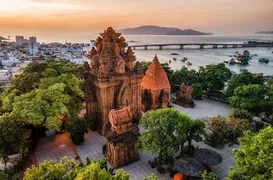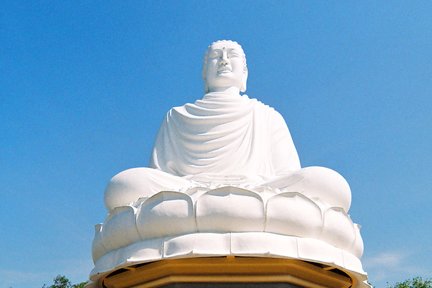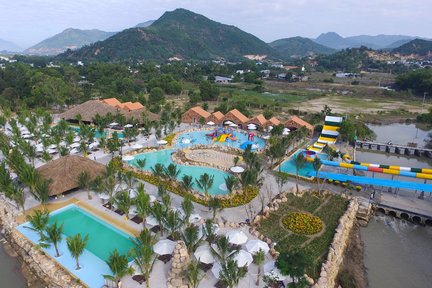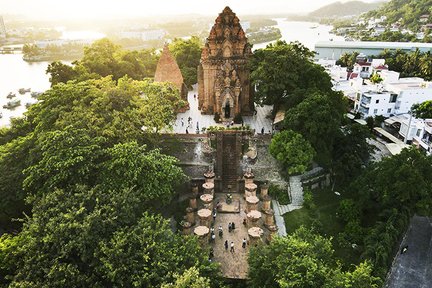Ponagar Tower

The best of Ponagar Tower
Bucket-list experiences
Make it a getaway
Trouble-free transport
More to explore
Why people love Ponagar Tower
Nearby places to go
FAQs about Ponagar Tower
When is the best time to visit Ponagar Tower in Nha Trang?
How can I get to Ponagar Tower from Nha Trang city center?
What local dishes should I try while visiting Nha Trang?
What should I wear when visiting Ponagar Tower?
Where should I stay for a convenient visit to Ponagar Tower?
What to know before visiting Ponagar Tower
Remarkable Landmarks and Must-Visit Sights
Main Tower
Prepare to be awestruck by the Main Tower of Po Nagar, a towering 25-meter-high marvel of Cham architecture. This iconic structure houses a 1.2-meter tall stone statue of the goddess Yan Po Nagar, depicted with ten hands holding various symbolic items. The intricate details and historical significance of this tower make it a must-see for any visitor to Nha Trang.
Ponagar Cham Towers
Step into a world of ancient splendor at the Ponagar Cham Towers, a complex of relics dating from the 7th to the 13th centuries. Perched on a 10-meter-high hill beside the Cai River, this site offers breathtaking natural scenery and a harmonious blend of mountains and rivers. Explore the gate tower, the vestibule (Mandapa), the temple and tower area (Kalan), and the inscription area, each brimming with unique architectural and historical treasures.
North Tower (Thap Chinh)
Standing tall at 28 meters, the North Tower is the crown jewel of the Ponagar complex. Built in AD 817, this magnificent structure features a terraced pyramidal roof, vaulted interior masonry, and a vestibule adorned with inscriptions. Inside, you'll find a striking black-stone statue of the goddess Uma with 10 arms, seated against a monstrous beast. This tower's grandeur and historical depth make it an essential stop on your visit.
Cultural Significance
Po Nagar Tower is more than just a stunning architectural site; it's a cultural treasure that embodies the religious traditions of the Cham people. Dedicated to the goddess Yan Po Nagar, the temple complex is a spiritual haven for both Hindu and Buddhist followers.
Historical Events
Po Nagar Tower has a rich history marked by invasions and restorations. Significant moments include its restoration by King Satyavarman in 781 and contributions from Cham rulers like Harivarman I and Jaya Indravarman III.
Architectural Style
The Po Nagar complex is a testament to Champa architecture, featuring intricate carvings, towering structures, and symbolic sculptures. The design highlights the artistic and engineering skills of the Cham civilization.
Cultural and Historical Significance
Ponagar Cham Towers are a symbol of Nha Trang City and a must-visit for tourists. Built to honor Queen Po Ina Nagar, the goddess of creation, the site is deeply significant in the spiritual life of the Cham people and showcases their rich artistic heritage.
Special Cultural Festival
If you visit Ponagar Cham Towers during the third lunar month, you'll experience the largest Cham festival in the Central Highlands and South Central regions. The festival features unique folk religious activities like shadow dance, lion dance, and peace prayers.
Local Cuisine
While exploring Ponagar Cham Towers, don't miss out on the local Nha Trang cuisine. Treat yourself to fresh seafood, Nem Nuong (grilled pork sausage), and Bun Cha Ca (fish cake noodle soup) for a delightful culinary adventure.
Cultural and Historical Significance
The Ponagar Tower complex has been a revered site since the 2nd century AD, dedicated to Yang Ino Po Nagar, the goddess of the Dua (Liu) clan. The inscribed stone slabs provide fascinating insights into the spiritual and social life of the Cham people.
Architectural Marvels
The towers are a blend of stone and brick construction, showcasing the architectural brilliance of the Cham civilization. The North Tower, with its pyramidal roof and intricate carvings, is particularly impressive.
Religious Practices
The site remains a place of worship for Cham, Chinese, and Vietnamese Buddhists. Visitors are expected to remove their shoes and dress respectfully when entering the temples.



